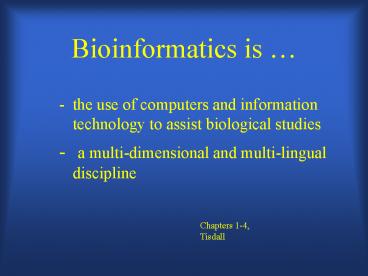Bioinformatics is PowerPoint PPT Presentation
1 / 18
Title: Bioinformatics is
1
Bioinformatics is
- - the use of computers and information
technology to assist biological studies - - a multi-dimensional and multi-lingual
discipline
Chapters 1-4, Tisdall
2
Multiple platforms, multiple languages
- Windows, Mac, UNIX, Linux
- UNIX remains the standard for bioinformatics
software development, while PCs and Macs are
typically end-users. - Java, Python, CORBA, C, Ruby, Perl
- Theres more than one way of doing things.
- Uniformity continues to be one of the biggest
problems faced in bioinformatics
3
Why Perl?
- Ease of use by novice programmers
- Fast software prototyping
- Flexible language
- Compact code (sometimes)
- Powerful pattern matching via regular
expressions - Availability of program and modules (BioPerl)
- Portability
- Open Source easy to extend and customize
- No Licensing fees
4
Perl is easy to get
- Many computers come with Perl already installed
- Check by typing perl v in a Unix, Linux, MacOSX
shell, or Windows MS-DOS shell - If not, simply go to www.perl.com, or
www.activestate.com to download a recent version
of Perl (download binary whenever possible,
source code requires compiling) - ActiveState provides several tools for Perl
developers (Although some think Perl is an old
language, it is constantly undergoing revision
and improvement
5
What is Perl?
- Practical Extraction Report Language
- An interpreted programming language optimized for
scanning text files, extracting information, and
printing reports - The string-based language of DNA and protein
sequence data makes this an obvious choice
6
What is a Perl program?
- A program consists of a text file containing a
series of Perl statements - Perl programs can be written in a variety of text
editors including MS Word, WordPad, NotePad, or
as you will use Komodo from ActiveState - Perl statements are separated by semi-colons ()
- Multiple spaces, tabs, and blank lines are
ignored - Anything following a is ignored (comment line)
- Perl is case sensitive
7
Perl has three data types
- - Scalar holds a single value, which can be a
number or string, EcoRI GAATTC - _at_ - Array stores multiple scalar values 0, 1,
2, etc. - - Hash An associative array with keys and
values
8
Using Scalar Variables
- Example 4-1 Tisdall provides a simple example, a
thorough description of this exercise is supplied
both in the text
9
Some additional comments regarding strings
- Quotes
- XYZ Text between a pair of single quotes is
interpreted literally - To get a single-quote in a string precede it by a
backslash - To get a backslash into a single quoted string,
precede backslash with backslash - hello hello
- can\t cant
- http\\\\www http\\www
10
Double quotes interpolate variables
- variable names within the string are replaced
by their current values - x 1
- print x will print out x
- print x will print out 1
11
Arithmetic operators
- Addition
- - Subtraction
- Multiplication
- Exponentiation
- / Division
- Modulus
12
Other important operators
- is an assignment operator
- or eq is equals
- or - assignment operators that add or
subtract, a 2 means a a 2 - ,, -- are autoincrement operators that add or
subtract one from variable when following
variable (a a 1)
13
\n newline
- Often times you would like to introduce some
spacing into your output - \n introduces a blank line following any variable
- Print apple
- print grape
- Output looks like apple
- grape
- Print apple\n
- print grape\n
- Output looks like apple
- grape
14
Chomp and Chop
- Chop removes the last character from a string
- a Dr. Barber is hip
- Chop (a) a is now Dr. Barber is hi
- Chomp removes a line from the end of the string
- a Dr. Barber is hip\n
- Chomp (a) a is now Dr. Barber is hip
15
- Do examples 4-2, 4-3, 4-4
16
Working with Files
Biological data can come in a variety of file
formats and our job is to utilize these files and
extract what we want One such file format is
FASTA
17
Scalar vs. Array
- Example 4-5 provides a simple distinction between
use of a scalar variable and an array, read it,
but dont necessarily do it - Also, it shows how you use filehandles in
association with your file - lt gt are input operators, you will become better
acquainted with this when we use ltSTDINgt later
18
adhI.pep
- Supplant NM_021964fragment.pep with adhI.pep,
which can be downloaded from the web-site to a
folder you need to create on your computer called
BIOS482 - Do Example 4-7, if time permits write analogous
code to the code that follows this example to
test out arrays

